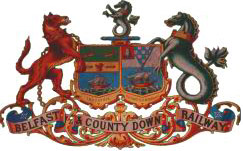
The Belfast and County Down Railway (BCDR) was an Irish gauge railway in Ireland linking Belfast with County Down. It was built in the 19th century and absorbed into the Ulster Transport Authority in 1948. All but the line between Belfast and Bangor was closed in the 1950s, although some of it has been restored near Downpatrick by a heritage line, the Downpatrick and County Down Railway.
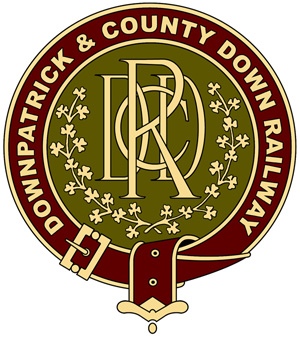
The Downpatrick and County Down Railway (DCDR) is a 5 foot, 3 inch gauge heritage railway in County Down, Northern Ireland. It is operated by volunteers and runs passenger trains using steam and diesel locomotives, diesel railcars, and vintage carriages. The railway has approximately three miles (4.8 km) of track in a triangular-shaped layout, which connects the town of Downpatrick with the historical sites of Inch Abbey to the north and King Magnus’ Grave to the south. It also houses a museum of railway artefacts and rolling stock originating from both Northern Ireland and the Republic of Ireland, dating from the 1860s to the 1980s.
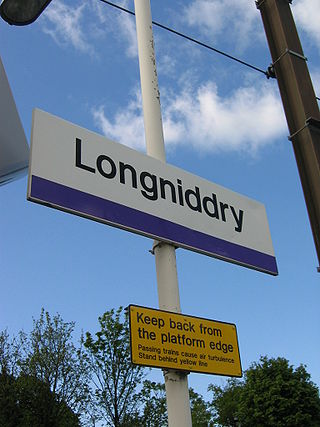
Longniddry railway station is located at the southeast corner of the coastal village of Longniddry, East Lothian, Scotland. The station is on the East Coast Main Line, 13+1⁄4 miles (21.3 km) east of Edinburgh Waverley, and is served by stopping passenger trains on the North Berwick Line.

Drem railway station serves the small village of Drem in East Lothian, 5 miles (8 km) from the seaside town of North Berwick in Scotland. It is located on the East Coast Main Line (ECML) 18 miles (29 km) east of Edinburgh Waverley. Passenger services are provided on the ScotRail North Berwick Line, and the junction where the North Berwick branch diverges from the ECML is a short distance to the east of the station.

Antrim railway station opened 1848 and serves the town of Antrim in County Antrim, Northern Ireland.

Abergynolwyn railway station is a station on the Talyllyn Railway near Abergynolwyn, Gwynedd, in Mid-Wales. It is 6.55 miles (10.54 km) from Tywyn Wharf. The name 'Abergynolwyn' means 'Mouth-of-the-River-with-a-Whirlpool'.

Bo'ness railway station is a heritage railway station in Bo'ness, Falkirk, Scotland. It is not the original Bo'ness railway station, which was located roughly a quarter mile west on Seaview Place, now the site of a car park.
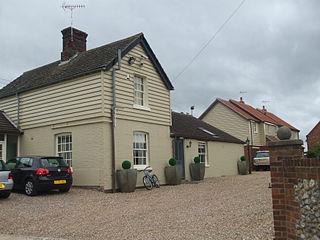
Burnham Market was a railway station which served the village of Burnham Market, Norfolk, England. Opened by the West Norfolk Junction railway in 1866, it closed with the line in 1952.

Adlestrop railway station was a railway station which served the village of Adlestrop in Gloucestershire, England, between 1853 and 1966. It was on what is now called the Cotswold Line. The station was immortalised in the poem "Adlestrop" by Edward Thomas after his train stopped there on 24 June 1914.

Rothienorman railway station,Rothie or Rothie Norman was a railway station in Rothienorman, Aberdeenshire on the rural branchline to Macduff. It lay 7.25 miles (11.7 km) from the junction at Inveramsay at 392 feet (119 m) above sea level, the summit of the line. The station served the village and the nearby Rothie Norman House and estate.

Turriff railway station was a railway station in Turriff, Aberdeenshire, Scotland. It was opened in 1857 by the Banff Macduff & Turriff Junction Railway, later part of the Great North of Scotland Railway, then the LNER and finally British Railways, on the branchline from Inveramsay to Macduff, the station closed to passengers in 1951 and to goods in 1966. The town lay to the north.

Ardglass railway station was the terminus of the Downpatrick, Killough and Ardglass Railway, which ran from Belfast south to Newcastle, County Down in Northern Ireland.
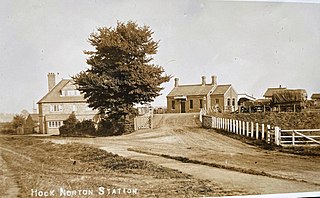
Hook Norton railway station served the village of Hook Norton in northern Oxfordshire, England.

Chipping Norton railway station served the town of Chipping Norton, Oxfordshire, England. The station had two platforms and a signal box. It was closed in 1964 and site now forms part of an industrial estate.
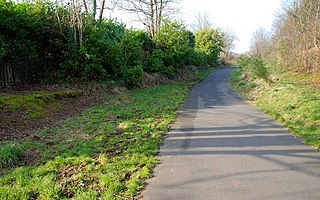
Neill's Hill railway station is a disused railway station / halt on the main line of the Belfast and County Down Railway. It ran from Queen's Quay, Belfast south to Newcastle, County Down in Northern Ireland.
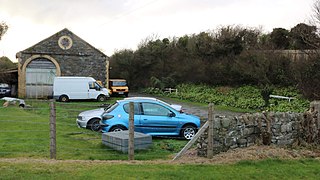
Killough railway station was on the Downpatrick, Killough and Ardglass Railway, which ran from Downpatrick to Ardglass in Northern Ireland.

Castlewellan railway station was on the Great Northern Railway (Ireland). It was located in the village of Castlewellan.

Comber railway station was on the Belfast and County Down Railway which ran from Belfast to Newcastle, County Down in Northern Ireland.

Downpatrick Loop Platform railway station is a junction station owned and operated by the Downpatrick and County Down Railway, heritage railway in Northern Ireland.

Inch Abbey railway station is a station on the Downpatrick and County Down Railway, a heritage railway in Northern Ireland. It is the terminus of the railway's North Line and serves Inch Abbey, a ruined monastery and local tourist attraction of Downpatrick notable for its use as a filming location in the HBO show Game of Thrones.


























